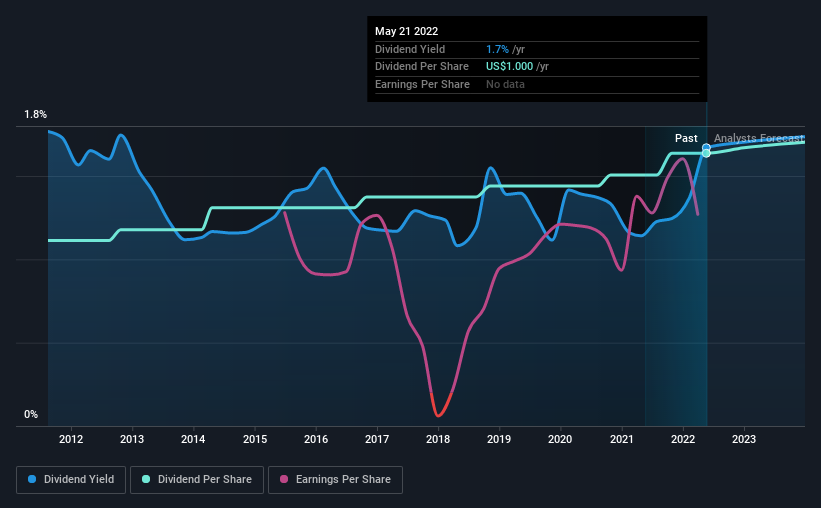Only Four Days Left To Cash In On Tennant's (NYSE:TNC) Dividend
Tennant Company (NYSE:TNC) stock is about to trade ex-dividend in four days. The ex-dividend date occurs one day before the record date which is the day on which shareholders need to be on the company's books in order to receive a dividend. It is important to be aware of the ex-dividend date because any trade on the stock needs to have been settled on or before the record date. Accordingly, Tennant investors that purchase the stock on or after the 27th of May will not receive the dividend, which will be paid on the 15th of June.
The company's upcoming dividend is US$0.25 a share, following on from the last 12 months, when the company distributed a total of US$1.00 per share to shareholders. Based on the last year's worth of payments, Tennant stock has a trailing yield of around 1.7% on the current share price of $59.9. We love seeing companies pay a dividend, but it's also important to be sure that laying the golden eggs isn't going to kill our golden goose! So we need to investigate whether Tennant can afford its dividend, and if the dividend could grow.
See our latest analysis for Tennant
Dividends are usually paid out of company profits, so if a company pays out more than it earned then its dividend is usually at greater risk of being cut. Fortunately Tennant's payout ratio is modest, at just 36% of profit. A useful secondary check can be to evaluate whether Tennant generated enough free cash flow to afford its dividend. Over the past year it paid out 129% of its free cash flow as dividends, which is uncomfortably high. It's hard to consistently pay out more cash than you generate without either borrowing or using company cash, so we'd wonder how the company justifies this payout level.
While Tennant's dividends were covered by the company's reported profits, cash is somewhat more important, so it's not great to see that the company didn't generate enough cash to pay its dividend. Were this to happen repeatedly, this would be a risk to Tennant's ability to maintain its dividend.
Click here to see the company's payout ratio, plus analyst estimates of its future dividends.
Have Earnings And Dividends Been Growing?
Stocks with flat earnings can still be attractive dividend payers, but it is important to be more conservative with your approach and demand a greater margin for safety when it comes to dividend sustainability. If earnings decline and the company is forced to cut its dividend, investors could watch the value of their investment go up in smoke. That explains why we're not overly excited about Tennant's flat earnings over the past five years. It's better than seeing them drop, certainly, but over the long term, all of the best dividend stocks are able to meaningfully grow their earnings per share. Earnings have been growing somewhat, but we're concerned dividend payments consumed most of the company's cash flow over the past year.
Many investors will assess a company's dividend performance by evaluating how much the dividend payments have changed over time. In the past 10 years, Tennant has increased its dividend at approximately 3.9% a year on average.
The Bottom Line
From a dividend perspective, should investors buy or avoid Tennant? Earnings per share have been effectively flat over this time, and Tennant's paying out less than half its profits and 129% of its cash flow. Only rarely do we find companies paying out a low percentage of their profits yet a high percentage of their cash flow, so we'd mark this as a concern. In summary, it's hard to get excited about Tennant from a dividend perspective.
However if you're still interested in Tennant as a potential investment, you should definitely consider some of the risks involved with Tennant. To help with this, we've discovered 2 warning signs for Tennant that you should be aware of before investing in their shares.
Generally, we wouldn't recommend just buying the first dividend stock you see. Here's a curated list of interesting stocks that are strong dividend payers.
Have feedback on this article? Concerned about the content? Get in touch with us directly. Alternatively, email editorial-team (at) simplywallst.com.
This article by Simply Wall St is general in nature. We provide commentary based on historical data and analyst forecasts only using an unbiased methodology and our articles are not intended to be financial advice. It does not constitute a recommendation to buy or sell any stock, and does not take account of your objectives, or your financial situation. We aim to bring you long-term focused analysis driven by fundamental data. Note that our analysis may not factor in the latest price-sensitive company announcements or qualitative material. Simply Wall St has no position in any stocks mentioned.

 Yahoo Finance
Yahoo Finance 
